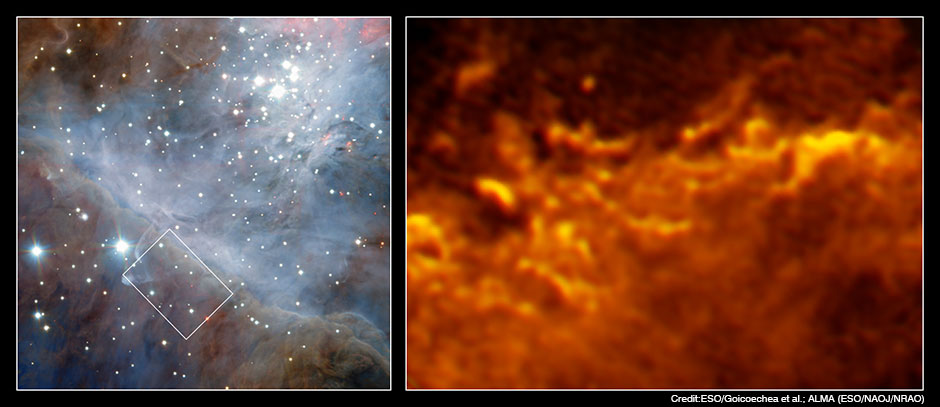The Shore of the Orion Nebula
Astrophotography・

The “Orion Nebula” is famous for its high star formation activity. Thousands of young stars crowd together in it, most notably the four young giant stars forming “Trapezium.” This nebula can be said to be the most popular target to observe in astronomy. The left image is the “Orion Nebula” captured in the infrared by the Very Large Telescope (VLT) of the European Southern Observatory (ESO). The right picture is a radio image of the region indicated by the white rectangle in the corner of the left picture. This region was captured in high resolution by ALMA and the Spanish IRAM 30-meter telescope.
The Boundary of a Violently Undulating Nebula
The “Orion Nebula” is a gigantic assembly of gases, shining with the light of young stars. These young stars, especially the giant stars “Trapezium,” emit intense ultraviolet light, irradiating the surrounding gas. The strong ultraviolet light destroys the molecular gas and converts it into high temperature plasma. The right image captured the radio waves emitted from the molecular gas. This image shows us exactly how and where the nebula gas churns as it is destroyed.
Text by: Masaaki Hiramatsu (NAOJ Chile Observatory)
Translation by: Hiroko Tsuzuki and Ramsey Lundock (Public Relations Center, NAOJ)
Image Data
| Object | Orion Nebula |
|---|---|
| Telescope | ALMA, IRAM 30-meter radio-telescope, ESO VLT |
| Instrument | ALMA Band 7 Receiver, IRAM 30-meter radio-telescope EMIR330, VLT HAWK-I |
| Wavelength | 0.87 millimeter (ALMA, IRAM 30m) |
| Credit | ESO/Goicoechea et al.; ALMA (ESO/NAOJ/NRAO) |